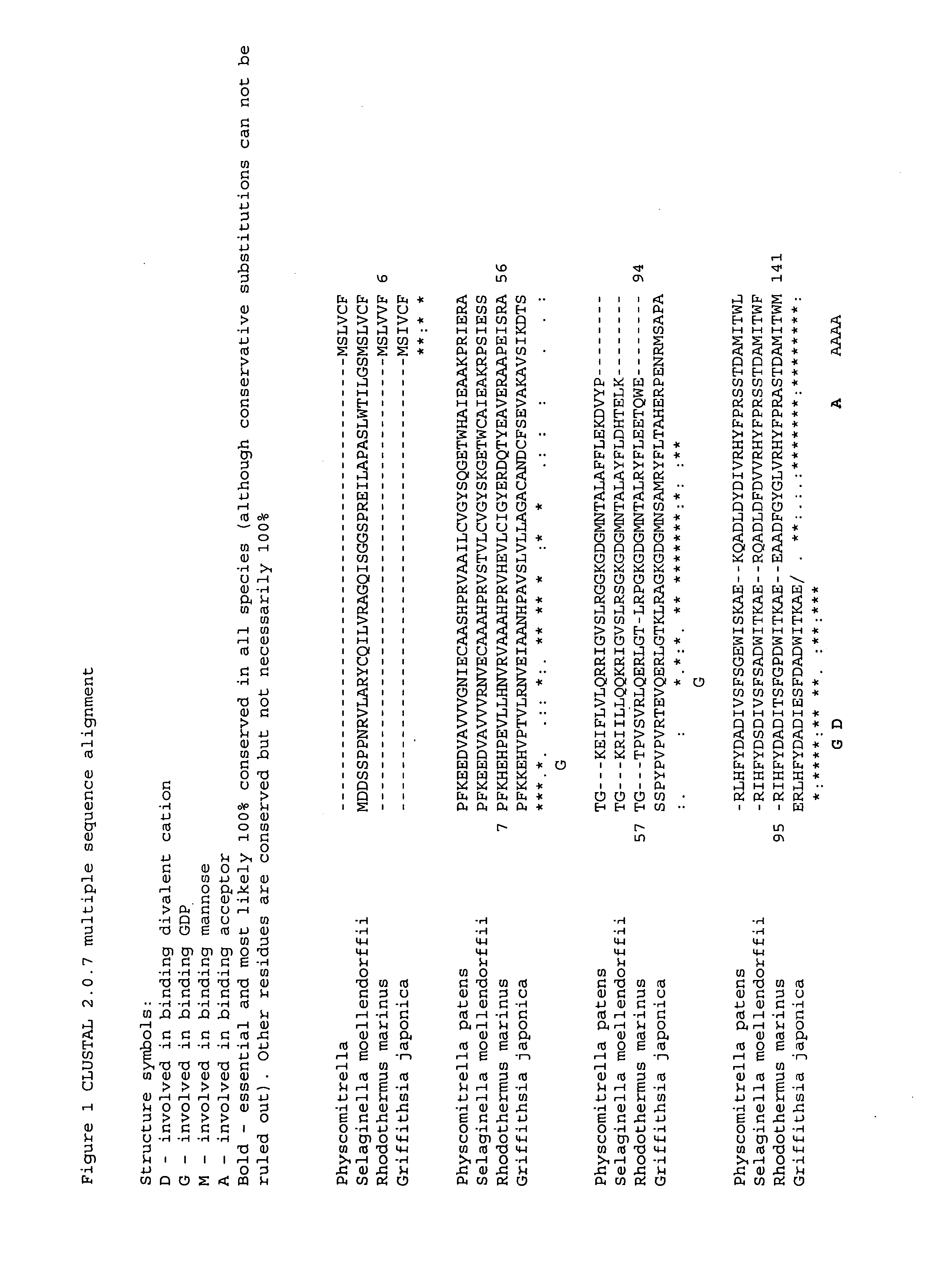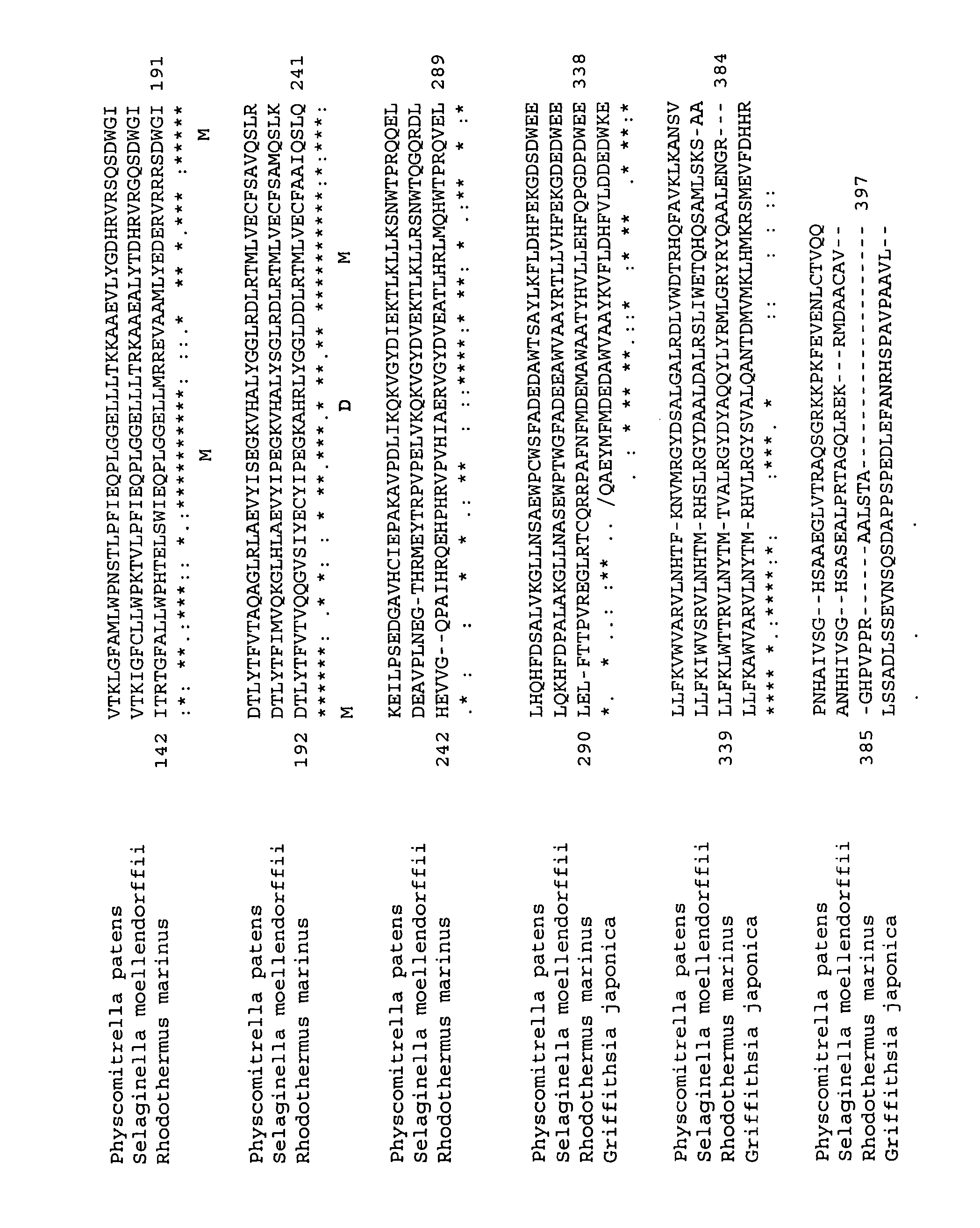Stress-tolerant plants expressing mannosylglycerate-producing enzymes
a technology of stress-tolerant plants and enzymes, applied in the field of stress-tolerant plants expressing mannosylglycerate-producing enzymes, can solve the problems of limited water resources for agriculture, affecting plant production, and limited areas suitable for plant growth, and achieves the effect of increasing tolerance to drough
- Summary
- Abstract
- Description
- Claims
- Application Information
AI Technical Summary
Benefits of technology
Problems solved by technology
Method used
Image
Examples
example 1
Expression of MG Synthase
[0103]The sequence of the mannosylglycerate synthase gene from Selaginella moellendorffii GT78A1 is shown in SEQ ID NO:5. The sequence was codon optimized for its expression in plants. SEQ ID NO:7 provide an example of a codon-optimized sequence that was used in the present examples, but it is generally appreciated in the art that there are many other codon-optimized alternatives that can be used based on the following: Codon use satisfies the criteria for translation in the host cell and the change in codon use does not introduce new secondary structures in the transcript. SEQ ID NO:7 was synthesized by Genscript and inserted into a suitable vector. Many vectors are known that can be used. In this example, pUC57, was employed.
[0104]The heat shock promoter (hsp81) (SEQ ID NO:9) was amplified using the following primers: forward primer containing a SacI site in the 5′end 5′ GGGGAGCTCGATATCGGTTTGAAGATGGCAAGTG 3′ (SEQ ID NO:10) and reverse primer containing a K...
example 2
Transformation of Arabidopsis and Tobacco Plants
[0111]The constructs with 35S and heat shock promoters were transformed into Agrobacterium tumefaciens and used for Agrobacterium mediated transformation of plants. Arabidopsis thaliana plants were transformed by the floral dip method with all three types of construct and Nicotiana benthamiana leaves were infiltrated with Agrobacterium carrying the pEarleyGate 201 construct according to Voinnet et al. (2003) for transient expression of the HA-tagged fusion protein. As understood in the art any number of different vectors can be employed. The vector pEarleyGate 201 is one example. Arabidopsis T1 transformants were selected by spraying with Basta and the presence of the transgene confirmed by PCR. Infiltrated Nicotiana plants were grown for 3 to 4 days before analysis for expression of the MG synthase. Expression of the gene in Arabidopsis was tested by RT-PCR (FIG. 2). Presence of the HA-tagged fusion protein in Nicotiana was confirmed ...
example 3
Production of MG in Transgenic Plants
[0112]Nicotiana plants expressing the HA-tagged MG synthase were grown for 3-4 days after infiltration before leaves were harvested. Arabidopsis stable transformants expressing either the unmodified MG synthase or the HA-tagged fusion protein under control of 35S promoter were grown for 4-8 weeks before rosette leaves were harvested. Leaves (20-100 mg) were frozen in liquid nitrogen and crushed to a powder using a metal ball shaker. Shaking was at 20 Hz for 1-2 min. The leaf powder was added 1 ml of chloroform / methanol 1:1 and 250 μl of water. The sample was thoroughly vortexed, and was let to stand at 4° C. for 30 min before centrifugation at 10000×g for 5 min at 4 C. The aqueous (upper) phase was transferred to a new tube and 0.75 ml of chloroform was added. The sample was vortexed and centrifuged. The aqueous phase was transferred to a new tube and extracted again with 0.6 ml of chloroform and centrifuged. The aqueous phase was filtered in a s...
PUM
| Property | Measurement | Unit |
|---|---|---|
| Fraction | aaaaa | aaaaa |
| Stress optical coefficient | aaaaa | aaaaa |
| Drought | aaaaa | aaaaa |
Abstract
Description
Claims
Application Information
 Login to View More
Login to View More - R&D
- Intellectual Property
- Life Sciences
- Materials
- Tech Scout
- Unparalleled Data Quality
- Higher Quality Content
- 60% Fewer Hallucinations
Browse by: Latest US Patents, China's latest patents, Technical Efficacy Thesaurus, Application Domain, Technology Topic, Popular Technical Reports.
© 2025 PatSnap. All rights reserved.Legal|Privacy policy|Modern Slavery Act Transparency Statement|Sitemap|About US| Contact US: help@patsnap.com



